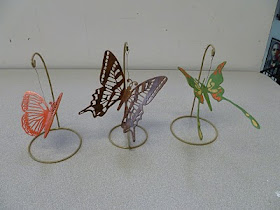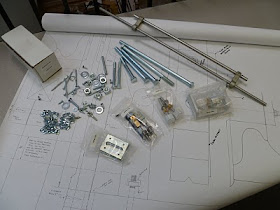
If you have been reading all the posts of this blog, you may ask "Why is this post 'Graduate Student Work IV'?" I should have mentioned that the post, "Butterflies Are For Eveveryone," which featured work by Karen Kaminiski, was actually ASFM Graduate Work III. It is my goal to feature work by students who contact me and provide me with photos and information about their creations. If you have completed any studies at the American School of French Marquetry, please send me something so I can use it to inspire others.
One of the first students in the school was a brain surgeon, Dr. Ken Stover. He is the kind of person who constantly asks questions and is pushing the envelope. It was a lot of fun having him in the class, and he returns as often as possible when class is in session to meet the new students. He is the person responsible for suggesting the third exercise in Stage I, which we call "beer coasters."
After completing two stages, he built his own chevalet and converted his garage into a large marquetry atelier. He purchased lots of sawn veneers from Patrick George, in Paris, and decided to create his masterpiece.
I often suggest that students practice on more basic etudes before attempting something grand. More often than not, they do not listen. Aaron was such a student, and so was Ken. He fixated on the table top made by Riesner, which was illustrated in Pierre's book, and announced to me that he would produce that design for his headboard, which would be 36 x 60".
To accomplish a project of this size required that he make a saw frame with a throat of 67cm for his chevalet. Still, he had to bring the full size packet to the school to use the overhead saw to cut it into smaller pieces. When he left, he had cut the project into 11 individual packets, which he could then cut further with his chevalet at home.
Using a 2/0 Pebeco German blade, and the Painting in Wood method, he began work. Over several years he cut pieces, when he had the time. From time to time he would bring in part of the project to share with me and the class. The total time spent was 1650 hours and there were over 5,000 pieces total.
All of the necessary elements were then put into hot sand to create shadows, and the picture was assembled on an assembly board. Mastic was applied and it was glued to a substrate and cleaned up, as usual. Shellac finished it off.
Ken asked Aaron Radelow to carve the frame, and he did an exceptional job. You may remember Aaron as having created the fantastic ivory and horn tables, featured in an earlier post (ASFM Graduate Work I). It is obvious he has a wide range of talent.
It is odd...I have a background in physics, and I often say to people, "Marquetry is not rocket science." In this case, I should add, "Marquetry is not brain surgery." Just do it.













